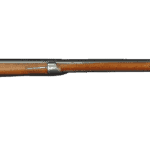
The Model 1812 Musket: Development, Manufacture, and Use
The Model 1812 Musket holds a significant place in the history of firearms, particularly in the United States. It was a pivotal weapon that played a crucial role in several conflicts during the early 19th century. This article aims to provide an in-depth exploration of the development, manufacture, and use of the Model 1812 Musket, as well as its predecessors and contemporary battle rifles
Development and Manufacture:
The Model 1812 Musket was a smoothbore, flintlock musket that was developed to replace the preceding Model 1795 Musket. It was primarily manufactured by two prominent American gun manufacturers of the time: Eli Whitney and Robert Johnson.
- Eli Whitney:
Eli Whitney, known for his invention of the cotton gin, also played a vital role in the manufacturing of firearms. His factory in New Haven, Connecticut, produced a significant number of Model 1812 Muskets. Whitney's factory was known for employing interchangeable parts, which greatly enhanced the efficiency of production and maintenance. - Robert Johnson:
Robert Johnson, based in Middletown, Connecticut, was another prominent manufacturer of the Model 1812 Musket. His factory produced muskets of exceptional quality, and Johnson's reputation for craftsmanship was highly regarded.
Production and Usage
The production of Model 1812 Muskets spanned several years, with the majority being manufactured between 1812 and 1815. The exact number of muskets produced is uncertain, but estimates suggest that around 80,000 to 100,000 muskets were manufactured during this period.
- United States:
The Model 1812 Musket was widely used by the United States during the War of 1812. It was the primary shoulder arm for American infantry units during this conflict. The musket's reliability and ease of use made it a suitable weapon for soldiers in various engagements against British forces. - Other Countries:
Although primarily used by the United States, the Model 1812 Musket also saw use in other countries. The United States government sold surplus muskets to several Latin American countries during the early 19th century. These muskets aided the struggles for independence in nations such as Mexico, Colombia, and Venezuela.
Cartridges and Performance
The Model 1812 Musket utilized a paper cartridge system for ammunition. The cartridges consisted of a lead ball, black powder, and a pre-measured charge. Soldiers would tear open the cartridge, pour the powder into the musket's barrel, and then place the lead ball on top. The ball was then pushed down the barrel using a ramrod.
As a smoothbore musket, the Model 1812 lacked the accuracy and range of later rifled firearms. Its effective range was limited to around 100 yards (91 meters). However, the musket's firepower lay in its ability to deliver mass volleys of lead projectiles. The Model 1812 was designed to be used in formations, where its effectiveness was maximized by synchronized fire.
Predecessors of the Model 1812 Musket
The Model 1812 Musket was preceded by the Model 1795 Musket, which had been the standard shoulder arm of the United States Army since its adoption. The Model 1795 Musket was also a smoothbore flintlock musket and shared many similarities with the Model 1812.
Contemporary Battle Rifles
During the early 19th century, the Model 1812 Musket faced various contemporary battle rifles used by the United States, its allies, and enemies. Some notable examples include:
- British Brown Bess:
The British Brown Bess musket was the standard firearm for the British Army during the War of 1812. It was a smoothbore flintlock musket that had been in service for several decades. The Brown Bess had a similar design and performance to the Model 1812 Musket. - French Charleville Musket:
The French Charleville musket was the primary shoulder arm of the French Army during the Napoleonic Wars. It was a flintlock musket that was renowned for its craftsmanship and reliability. The Charleville musket influenced the design of American muskets, including the Model 1812. - Prussian 'Potsdam' Musket:
The Prussian 'Potsdam' musket was widely used by Prussian and German forces during the early 19th century. It was a smoothbore flintlock musket known for its durability and simplicity. The 'Potsdam' musket served as an inspiration for the Model 1795 and, subsequently, the Model 1812.
Conclusion
The Model 1812 Musket, developed and manufactured during the early 19th century, played a significant role in the War of 1812 and other conflicts of the time. Its production by notable manufacturers like Eli Whitney and Robert Johnson, its usage by the United States and other countries, and its performance on the battlefield all contribute to its historical importance. Understanding the Model 1812 Musket and its place among its predecessors and contemporaries provides valuable insight into the evolution of firearms technology and its impact on warfare during that era.
Discussion groups about the Model 1812 Musket can be found here.
If you know of any forums or sites that should be referenced on this listing, please let us know here.




